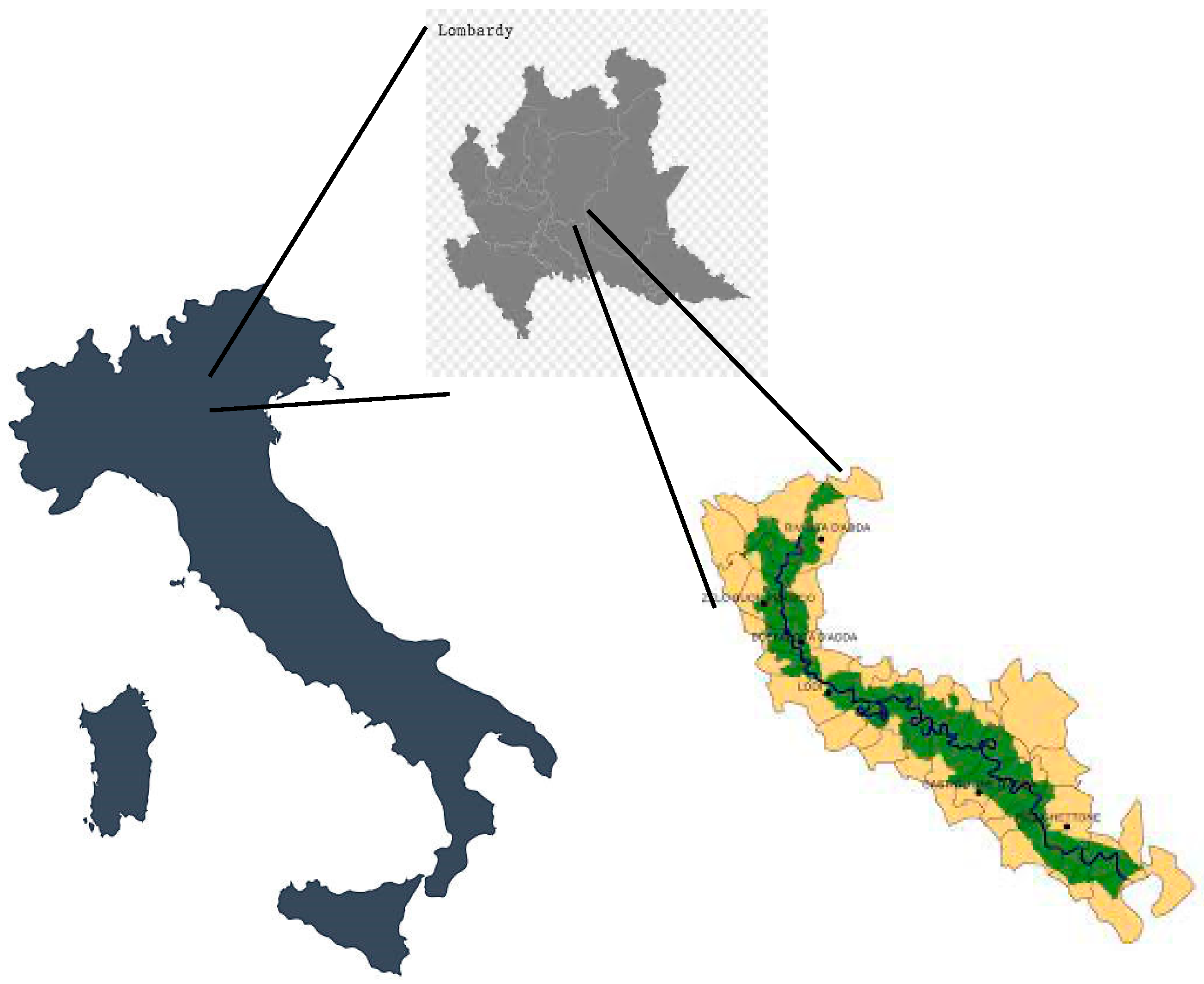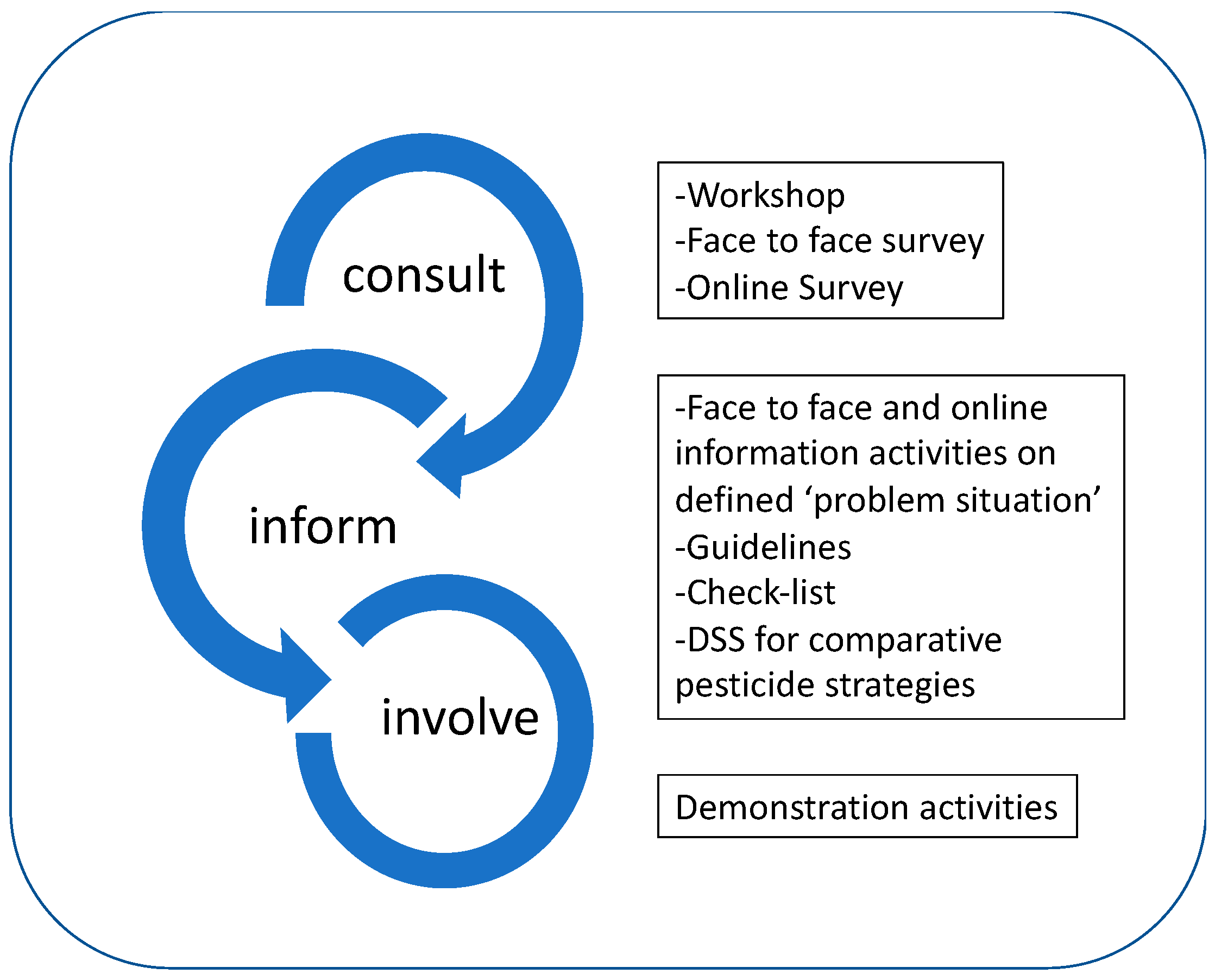Integrating Environmental and Social Dimensions with Science-Based Knowledge for a Sustainable Pesticides Management—A Project of Lombardy Region in Italy
Abstract
1. Introduction
2. Materials and Methods
2.1. Area of Study
2.2. Materials and Methods
2.2.1. STEP 1—Engagement Activities to Consult, Inform, and Involve, and Promotion of the Interdisciplinary Views
Stakeholders Involved
Inform—Initiatives to Provide Input to the Community with the Aim to Inform, Educate, or Raise Awareness
Involve—Initiatives That Build Active and Connected Communities
2.2.2. STEP 2—Development of Tools for Enhancing the Knowledge on the Sustainable Use of Pesticides
2.2.3. STEP 3—Development of a Context- and Farm-Specific Indicator for a Comparative Evaluation of Different Phytosanitary Strategies
3. Results
3.1. Step1
3.1.1. Engagement Activities to Consult
- It is necessary to strengthen the link between agriculture and research;
- The farmers of the reference area are trained, but the training is disconnected from reality;
- In the study area, the transmission of information is “relational” and certain figures, such as the contractor and the consultant/extensor, are important;
- Information on the sustainable use of pesticides must be context-specific;
- Avoid the traditional top-down approach.
3.1.2. Engagement Activities to Inform
3.1.3. Engagement Activities to Involve
3.2. STEP2 and STEP3—Development of Tools for Enhancing Knowledge
- Structural issues—such as pesticide storage, sprayers, structures for preparing mixtures; and
- Behavioral issues—best practices to encourage the correct behavior of the operator/worker.
4. Discussion
5. Conclusions
Author Contributions
Funding
Institutional Review Board Statement
Informed Consent Statement
Data Availability Statement
Acknowledgments
Conflicts of Interest
References
- Liu, T.; Bruins, R.J.; Heberling, M.T. Factors Influencing Farmers’ Adoption of Best Management Practices: A Review and Synthesis. Sustainability 2018, 10, 432. [Google Scholar] [CrossRef] [PubMed]
- Sandhu, H. Bottom-Up Transformation of Agriculture and Food Systems. Sustainability 2021, 13, 2171. [Google Scholar] [CrossRef]
- Van Cauwenbergh, N.; Biala, K.; Bielders, C.; Brouckaert, V.; Franchois, L.; Cidad, V.G.; Hermy, M.; Mathijs, E.; Muys, B.; Reijnders, J.; et al. SAFE a hierarchical framework for assessing the sustainability of agricultural systems. Agric. Ecosyst. Environ. 2007, 120, 229–242. [Google Scholar] [CrossRef]
- Hani, F.; Braga, F.S.; Stampfli, A.; Keller, T.; Fischer, M.; Porsche, H. RISE, a tool for holistic sustainability assessment at the farm level Int. Food Agribus. Manag. Rev. 2003, 6, 78–90. [Google Scholar]
- Talukder, B.; Hipel, K.W.; vanLoon, G.W. Using multi-criteria decision analysis for assessing sustainability of agricultural systems. Sustain. Dev. 2018, 26, 781–799. [Google Scholar] [CrossRef]
- FAO Sustainability Pathway. Available online: http://www.fao.org/nr/sustainability/en/ (accessed on 27 March 2023).
- Campling, P.; Joris, I.; Calliera, M.; Capri, E.; Marchis, A.; Kuczyńska, A.; Vereijken, T.; Majewska, Z.; Belmans, E.; Borremans, L.; et al. A multi-actor, participatory approach to identify policy and technical barriers to better farming practices that protect our drinking water sources. Sci. Total Environ. 2020, 755, 142971. [Google Scholar] [CrossRef] [PubMed]
- Barlagne, C.; Bézard, M.; Drillet, E.; Larade, A.; Diman, J.L.; Alexandre, G.; Vinglassalon, A.; Nijnik, M. Stakeholders’ engagement platform to identify sustainable pathways for the development of multi-functional agroforestry in Guadeloupe, French West Indies. Agroforest. Syst. 2023, 97, 463–479. [Google Scholar] [CrossRef]
- Ayala-Orozco, B.; Rosell, J.A.; Merçon, J.; Bueno, I.; Alatorre-Frenk, G.; Langle-Flores, A.; Lobato, A. Challenges and strategies in place-based multi-stakeholder collaboration for sustainability: Learning from experiences in the Global South. Sustainability 2018, 10, 3217. [Google Scholar] [CrossRef]
- Browse Project, FP7 Bystanders, Residents, Operators and Workers Exposure Models for Plant Protection Products, 2011–2013. Available online: https://cordis.europa.eu/project/id/265307 (accessed on 27 March 2023).
- Waterprotect Project H2020: Innovative Tools Enabling Drinking WATER PROTECTion in Rural and Urban Environments. Project ID: 727450, 2017–2020. Available online: https://water-protect.eu/en (accessed on 27 March 2023).
- Innoseta Project H2020 Innovative Spraying Equipment, Training and Advising. Available online: http://www.innoseta.eu (accessed on 27 March 2023).
- Calliera, M.; L’Astorina, A. The Role of Research Communication, and Education for a Sustainable Use of Pesticides. In Advances in Chemical Pollution, Environmental Management and Protection; Capri, E., Alix, A., Eds.; Academic Press: Cambridge, MA, USA; Elsevier Inc.: Amsterdam, The Netherlands, 2018; Volume 2, ISBN 978-0-12-812866-4. [Google Scholar]
- EIP Agri Network. Available online: https://ec.europa.eu/eip/agriculture/en/about/akis-eip-agri-spotlight (accessed on 22 March 2023).
- RICA Policy Brief Lombardia-2019-Pubblicato il 15 Novembre 2019 in Analisi Regionali. Available online: https://rica.crea.gov.it/policy-brief-lombardia-2019-773.php (accessed on 27 March 2023).
- Mercadante, R.; Dezza, B.; Mammone, T.; Moretto, A.; Fustinoni, S. Use of Plant Protection Products in Lombardy, Italy and the Health Risk for the Ingestion of Contaminated Water. Toxics 2021, 9, 160. [Google Scholar] [CrossRef]
- D.g.r. 29 Dicembre 2021—N. XI/5836 Aggiornamento delle Linee Guida per l’Attuazione in Lombardia del Piano di Azione Nazionale per l’Uso Sostenibile dei Prodotti Fitosanitari (PAR). Available online: https://fitosanitario.regione.lombardia.it/wps/portal/site/sfr/protezione-delle-colture-e-del-verde/PAR (accessed on 27 March 2023).
- Calliera, M.; Berta, F.; Meriggi, P.; Rossi, R.; Galassi, T.; Mazzini, F.; Bernard, A.; Bassi, R.; Guardo, D.; Marchis, A.; et al. Enhance knowledge on sustainable use of Plant Protection Products within the framework of the Sustainable Use Directive. Pest Manag. Sci. 2013, 69, 883–888. [Google Scholar] [CrossRef] [PubMed]
- Belmans, E.; Campling, P.; Dupon, E.; Joris, I.; Kerselaers, E.; Lammens, S.; Messely, L.; Pauwelyn, E.; Seuntjens, P.; Wauters, E. The Multiactor Approach Enabling Engagement of Actors in Sustainable Use of Chemicals in Agriculture. In Advances in Chemical Pollution, Environmental Management and Protection; Capri, E., Alix, A., Eds.; Academic Press: Cambridge, MA, USA; Elsevier Inc.: Amsterdam, The Netherlands, 2018; Volume 2, ISBN 978-0-12-812866-4. [Google Scholar]
- Dean, A.J.; Fielding, K.S.; Ross, H.; Newton, F. Community Engagement in the Water Sector: An Outcome Focused Review of Different Engagement Approaches; Cooperative Research Centre for Water Sensitive Cities: Melbourne, Australia, 2016. [Google Scholar]
- ERSAF, Mappa di Uso del Suolo della Regione Lombardia. Available online: https://www.ersaf.lombardia.it/it/servizi-al-territorio/dati-e-applicazioni-del-territorio/banca-dati-dell’uso-e-copertura-del-suolo (accessed on 27 March 2023).
- SCAR AKIS. Preparing for Future Akis in Europe—4th Report of the Strategic Working Group on Agricultural Knowledge and Innovation Systems. 2019. Available online: https://scar-europe.org/index.php/akis-documents (accessed on 22 March 2023).
- European Commission. Directive 2009/128/EC of the European Parliament and of the Council of 21 October 2009 Establishing a Framework for Community Action to Achieve the Sustainable Use of Pesticides. OJL 309 24.11.2009. 2009; pp. 71–86. Available online: http://data.europa.eu/eli/dir/2009/128/oj (accessed on 27 March 2023).
- European Commission. Commission Staff Working Document Evaluation of the CAP’s Impact on Knowledge Exchange and Advisory Activities SWD(2022) 138 Final, Directorate-General for Agriculture and Rural Development (European Commission). Available online: https://op.europa.eu/en (accessed on 27 March 2023).
- Di Guardo, A.; Capri, E.; Calliera, M.; Finizio, A. MIMERA: An online tool for the sustainable pesticide use at field scale. Sci. Total Environ. 2022, 846, 157285. [Google Scholar] [CrossRef] [PubMed]
- Chatman House. Available online: https://www.chathamhouse.org/about-us/chatham-house-rule (accessed on 22 March 2023).
- ISTAT Settimo Censimento Generale dell’Agricoltura Italiana, RAPPORTO ANNUALE 2022, La Situazione del Paese. Istat ISBN 978-88-458-2079-3 (stampa) ISBN 978-88-458-2080-9 (elettronico). Available online: https://www.istat.it/it/archivio/271806 (accessed on 27 March 2023).
- Smit, A.B.; Jager, J.H.; Manshanden, M.; Bremmer, J. Cost of Crop Protection Measures; PE 690.043; EPRS | European Parliamentary Research Service, European Union: Brussels, Belgium, 2021; ISBN 978-92-846-8392-5. [Google Scholar] [CrossRef]
- TOPPS Project. Available online: http://www.topps-life.org (accessed on 22 March 2023).
- Osservatorio Smart Agrifood. Report of the Event “Il Digitale è Servito, dal Campo allo Scaffale la Filiera Agroalimentare è Sempre più Smart”, Aprile 2020. Available online: www.osservatori.net (accessed on 27 March 2023).
- Etude Agrinautes 2018 Réalisée par BVA Pour Terre-Net Média et Hyltel. Available online: http://fichiers.hyltel.fr/PDF/AGRINAUTES_2018.pdf (accessed on 27 March 2023).
- Building Stronger Agricultural Knowledge and Innovation Systems (AKIS) to Foster Advice, Knowledge and Innovation in Agriculture and Rural Areas. April 2019. Available online: https://ec.europa.eu/info/sites/info/files/food-farming-fisheries/key_policies/documents/building-stronger-akis_en.pdf (accessed on 27 March 2023).
- Directorate-General for Research and Innovation of the European Commission; Webb, P.; Sonnino, R.; Fraser, E.; Arnold, T. Everyone at the Table: Transforming Food Systems by Connecting Science, Policy and Society; Publications Office of the European Union: Luxembourg, 2022; Available online: https://data.europa.eu/doi/10.2777/440690 (accessed on 27 March 2023).





| Survey 1 | Survey 2 | |
|---|---|---|
| Number of Respondent | 98 | 76 |
| Male | 84% | 87% |
| Phytosanitary treatments carried out | ||
| by the farm manager | 44% | 54% |
| by contractor | 29% | 17% |
| Decision taken by | ||
| own experience | 26% | 27% |
| private technician/advisor | 27% | 41% |
| retailer | 16% | 12% |
| Age of sprayer (excluding blank responses and contractors) | ||
| 0–3 years | 18% | 14% |
| 3–5 years | 32% | 24% |
| 5–10 years | 30% | 37% |
| More than 10 years | 13% | 25% |
| In-farm sprayer cleaning: | ||
| External sprayer cleaning | 60% | 76% |
| Internal sprayer cleaning | 58% | 46% |
Disclaimer/Publisher’s Note: The statements, opinions and data contained in all publications are solely those of the individual author(s) and contributor(s) and not of MDPI and/or the editor(s). MDPI and/or the editor(s) disclaim responsibility for any injury to people or property resulting from any ideas, methods, instructions or products referred to in the content. |
© 2023 by the authors. Licensee MDPI, Basel, Switzerland. This article is an open access article distributed under the terms and conditions of the Creative Commons Attribution (CC BY) license (https://creativecommons.org/licenses/by/4.0/).
Share and Cite
Calliera, M.; Di Guardo, A.; L’Astorina, A.; Polli, M.; Finizio, A.; Capri, E. Integrating Environmental and Social Dimensions with Science-Based Knowledge for a Sustainable Pesticides Management—A Project of Lombardy Region in Italy. Sustainability 2023, 15, 7843. https://doi.org/10.3390/su15107843
Calliera M, Di Guardo A, L’Astorina A, Polli M, Finizio A, Capri E. Integrating Environmental and Social Dimensions with Science-Based Knowledge for a Sustainable Pesticides Management—A Project of Lombardy Region in Italy. Sustainability. 2023; 15(10):7843. https://doi.org/10.3390/su15107843
Chicago/Turabian StyleCalliera, Maura, Andrea Di Guardo, Alba L’Astorina, Maurizio Polli, Antonio Finizio, and Ettore Capri. 2023. "Integrating Environmental and Social Dimensions with Science-Based Knowledge for a Sustainable Pesticides Management—A Project of Lombardy Region in Italy" Sustainability 15, no. 10: 7843. https://doi.org/10.3390/su15107843
APA StyleCalliera, M., Di Guardo, A., L’Astorina, A., Polli, M., Finizio, A., & Capri, E. (2023). Integrating Environmental and Social Dimensions with Science-Based Knowledge for a Sustainable Pesticides Management—A Project of Lombardy Region in Italy. Sustainability, 15(10), 7843. https://doi.org/10.3390/su15107843







